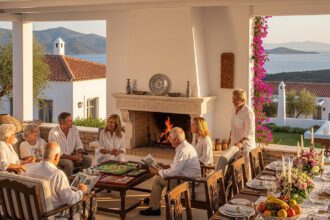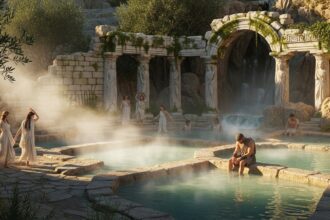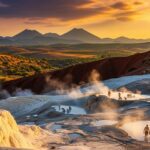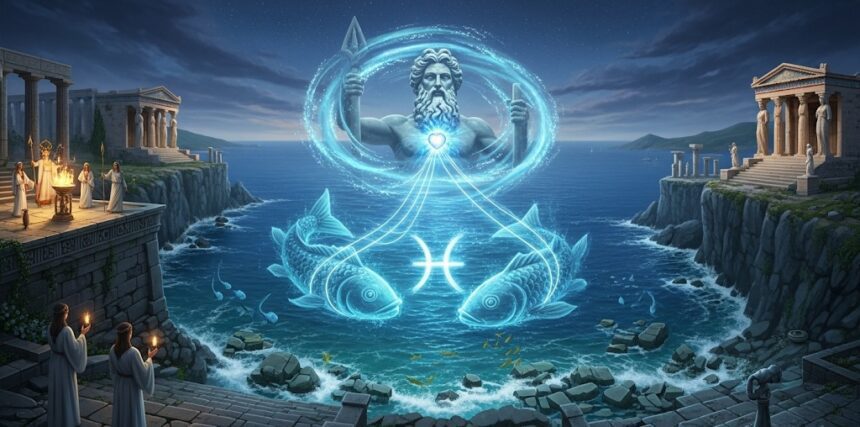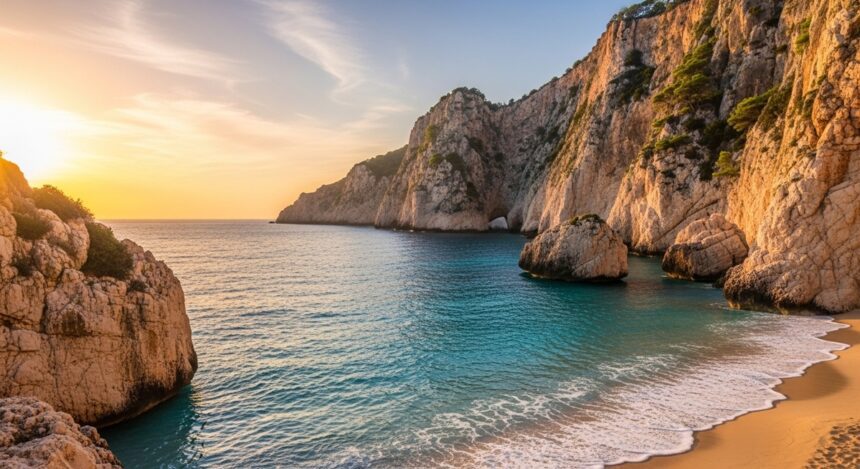Most travelers flock to Greece for its postcard-perfect vistas—think azure seas crashing against cliffs, crumbling ruins that whisper of gods and heroes, and those iconic blue-domed churches perched on hilltops. But peel back the layers of this ancient land, and you’ll discover a hidden world teeming with life that’s every bit as enchanting and enigmatic as the myths that birthed Western civilization. We’re talking about rare wildlife that doesn’t just survive here; it thrives in ways that echo the legends of old. From elusive mountain dwellers to guardians of the deep, these creatures form a secret menagerie that’s waiting to be explored. If you’re planning a trip beyond the beaches, this guide will unveil the strange and wonderful animals that make Greece a paradise for nature lovers.
What makes Greece’s wildlife so captivating? It’s the seamless blend of natural history and mythology. These animals aren’t just fauna; they’re living symbols, tied to tales of Zeus, Poseidon, and Artemis. And in a world where biodiversity is under threat, spotting them offers a thrilling mix of adventure and conservation awareness.
The Kri-Kri Goat: Wild Spirits of Crete’s Untamed Peaks
Deep in the heart of Crete, where the landscape shifts from olive groves to sheer, unforgiving gorges, the Kri-Kri goat reigns supreme. These aren’t your average farm animals—these are wild, wiry creatures with spiraling horns that can reach up to a meter long, adapted perfectly to a life of precarious leaps and solitary foraging. Known scientifically as Capra aegagrus cretica, the Kri-Kri is a subspecies unique to Greece, embodying the raw, untamed essence of the Mediterranean wilderness.
Imagine standing at the edge of the Samaria Gorge, a 16-kilometer chasm that’s one of Europe’s longest, and catching a glimpse of these ghosts in fur. They bound across rocks with an agility that defies gravity, their coats blending seamlessly with the sun-bleached stone. This is a portal to a primal world where survival is an art form.
Habitat and Survival Strategies: Masters of the Mountains
The Kri-Kri goat calls the White Mountains of western Crete home, favoring elevations above 1,000 meters where predators are few and vegetation is sparse but nutritious. They feast on hardy shrubs, herbs, and even the occasional olive branch, their digestive systems honed by millennia of evolution. But life isn’t easy—droughts, poaching, and habitat loss have pushed their numbers down to around 2,000 individuals. Conservation efforts, like those in the Samaria Gorge National Park, a UNESCO Biosphere Reserve, are crucial. Park rangers patrol tirelessly, and eco-tourism provides funding while educating visitors on minimal-impact viewing.

If you’re keen to spot one, head out at dawn or dusk when they’re most active. Bring binoculars and sturdy boots; the terrain is as challenging as it is rewarding. And remember, these animals are wild—keep your distance to avoid stressing them.
Mythological Ties: From Amaltheia to Modern Legends
No discussion of the Kri-Kri is complete without delving into Greek mythology. Ancient Cretans revered wild goats, linking them to Artemis, the goddess of the hunt, who was said to roam these very mountains. But the most famous tale involves Zeus himself. As an infant, hidden from his father Cronus, he was nursed by the divine goat Amaltheia, whose horn became the Cornucopia, symbol of abundance. Today’s Kri-Kri goats carry that legacy, their piercing eyes seeming to hold secrets from the gods.

Locals still share stories around tavern tables, calling them “agrimi” and weaving yarns about goats that lead lost hikers to safety. It’s this fusion of fact and folklore that makes encountering a Kri-Kri feel like stepping into a living myth.
Conservation Challenges and How You Can Help
With climate change altering rainfall patterns and invasive species encroaching, the Kri-Kri goat faces an uncertain future. Organizations like the Hellenic Society for the Protection of Nature are at the forefront, running breeding programs and anti-poaching initiatives. As a visitor, support by choosing guided tours from certified operators and donating to local wildlife funds. Every euro helps preserve these icons for generations to come.
Eleonora’s Falcon: The Aerial Acrobats of the Aegean
As summer wanes in Greece, the skies over the islands come alive with the swift silhouettes of Eleonora’s falcon. These raptors, Falco eleonorae, are nature’s precision engineers, diving at speeds up to 240 km/h to snatch prey mid-flight. What sets them apart? Their breeding cycle is timed to coincide with the autumn migration of songbirds, turning the Aegean into a feasting ground.

Picture this: You’re on a boat off the coast of Skyros, and suddenly, a flock of these falcons erupts into a synchronized hunt. Their dark plumage flashes against the blue horizon, cries piercing the air like ancient battle calls. It’s a spectacle that draws birdwatchers from around the globe.
Breeding Habits and Migration Marvels
Unlike typical falcons that nest in spring, Eleonora’s falcon waits until July or August, rearing chicks on a bounty of exhausted migrants heading south. Colonies can number in the hundreds, with Skyros hosting one of the largest—up to 1,000 pairs. Other hotspots include the Cyclades and Dodecanese islands, where cliffs provide ideal nesting sites.
These birds migrate vast distances, wintering in Madagascar and returning via the Middle East. This makes Greece a critical waypoint in global avian highways, underscoring the country’s role in biodiversity conservation.
Links to Ancient Lore: Hermes’ Winged Emissaries
In Greek mythology, falcons evoke Hermes, the fleet-footed messenger of the gods, known for his winged sandals and cunning. The Eleonora’s falcon‘s speed and grace mirror this, with ancient poets describing birds of prey as divine scouts. Named after a 14th-century Sardinian queen who protected them, these falcons blend medieval history with timeless myths.

Folktales abound of falcons guiding sailors or foretelling storms, adding a layer of magic to any sighting.
Protecting These Sky Guardians
With populations stable at around 15,000 pairs worldwide, Eleonora’s falcon isn’t critically endangered, but threats like pesticide use and habitat disturbance loom. The BirdLife International partnership in Greece monitors colonies and advocates for protected zones. Join citizen science programs or volunteer for nest surveys to contribute—it’s a hands-on way to safeguard these aerial wonders.
The Mediterranean Monk Seal: Silent Sentinels of the Sea
Diving into the turquoise depths off Alonissos, you might catch a fleeting glimpse of the Mediterranean monk seal, one of the planet’s rarest pinnipeds. Monachus monachus, with its soulful eyes and whiskered muzzle, looks more like a wise old sage than a marine predator. Once numbering in the tens of thousands, only about 700 survive today, making every encounter a privilege.

These seals haunt remote caves and rocky shores, surfacing silently to breathe before vanishing again. The Northern Sporades Marine Park, Europe’s first marine protected area, is their stronghold, where eco-boat tours offer ethical viewing opportunities.
Life in the Shadows: Habits and Haunts
Mediterranean monk seals are solitary by nature, feeding on fish, octopuses, and crustaceans in shallow waters. Females give birth in hidden lairs, pups learning to swim within days. Key sites include Karpathos, Crete, and the Ionian islands, where undisturbed coastlines allow them to thrive.

Human encroachment—fishing nets, tourism, and pollution—has decimated their numbers, but recovery programs are showing promise.
Divine Connections: Poseidon’s Sacred Guardians
Ancient Greeks saw the monk seal as sacred to Poseidon, believing they protected seafarers from storms. Homer mentions them in the Odyssey, and temples often featured seal motifs. Their “monk” name comes from the hooded appearance, evoking monastic robes, but it’s the mythical aura that endures—tales of seals singing laments for lost souls.
Urgent Conservation Efforts
Classified as endangered by the IUCN, the Mediterranean monk seal benefits from MOm, the Hellenic Society for the Study and Protection of the Monk Seal. They rescue injured seals and educate fishermen on net modifications. Support by avoiding crowded beaches and reporting sightings—your vigilance could save a life.
Caretta Caretta: The Timeless Turtles of Zakynthos
On the golden sands of Zakynthos, under a canopy of stars, the Caretta caretta loggerhead turtle enacts an age-old drama. These ancient reptiles, dating back 100 million years, haul ashore to nest, their flippers carving paths in the moonlight. Weighing up to 135 kg, they’re a testament to endurance in a changing world.

Laganas Bay is the epicenter, with over 1,000 nests annually. Strict regulations—dim lights, no vehicles—protect this ritual, allowing visitors to witness hatchlings’ dash to the sea.
Nesting Cycles and Oceanic Journeys
Female Caretta caretta return to their birth beaches every 2-3 years, laying clutches of 100 eggs. Incubation lasts 60 days, temperature determining sex. Juveniles roam the Atlantic before returning, navigating via magnetic fields.
Other sites include Kyparissia Bay in the Peloponnese and Crete‘s Rethymno Beach.
Symbolic Resonance: Emblems of Fertility and Renewal
In Greek mythology, turtles symbolize Gaia, the Earth Mother, and Aphrodite, born from sea foam. Their shells represent protection, their longevity echoing eternal cycles. Ancient coins bore turtle images, and poets lauded their wisdom.

Safeguarding the Future
Facing threats from plastic pollution and climate-driven sex imbalances, Caretta caretta is vulnerable. ARCHELON, the Sea Turtle Protection Society of Greece, runs patrols and rehab centers. Volunteer for nest monitoring or adopt a turtle—direct ways to aid these ancient mariners.
Greece’s Wildlife in the Modern Era
The old adage about “monkeys of Attica” might stem from misidentified martens or exaggerated traveler tales, but it highlights Greece‘s knack for surprising wildlife. Today, these animals face modern perils, yet they persist, inviting us to rethink our relationship with nature.
Venturing into this secret menagerie is a call to action. By supporting sustainable practices, we ensure these living legends survive. So, next time you’re in Greece, skip the crowded spots—seek the wild, and let the myths come alive.








